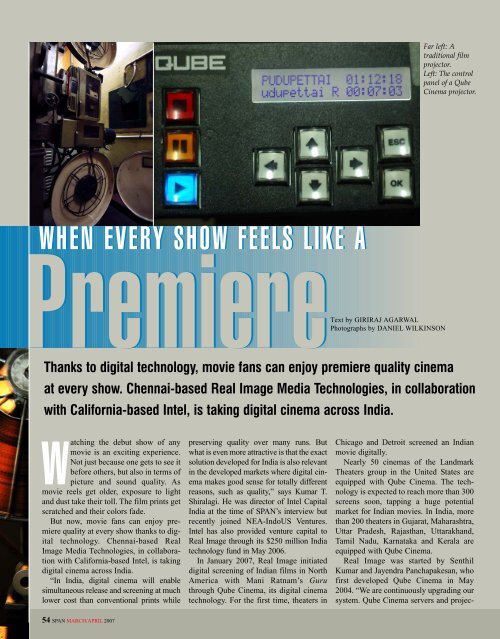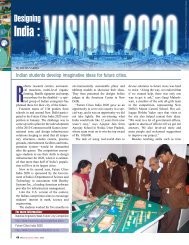Entertainment: Qube Cinema
Entertainment: Qube Cinema
Entertainment: Qube Cinema
Create successful ePaper yourself
Turn your PDF publications into a flip-book with our unique Google optimized e-Paper software.
WHEN EVERY SHOW FEELS LIKE A<br />
Premiere<br />
Watching the debut show of any<br />
movie is an exciting experience.<br />
Not just because one gets to see it<br />
before others, but also in terms of<br />
picture and sound quality. As<br />
movie reels get older, exposure to light<br />
and dust take their toll. The film prints get<br />
scratched and their colors fade.<br />
But now, movie fans can enjoy premiere<br />
quality at every show thanks to digital<br />
technology. Chennai-based Real<br />
Image Media Technologies, in collaboration<br />
with California-based Intel, is taking<br />
digital cinema across India.<br />
“In India, digital cinema will enable<br />
simultaneous release and screening at much<br />
lower cost than conventional prints while<br />
54 SPAN MARCH/APRIL 2007<br />
preserving quality over many runs. But<br />
what is even more attractive is that the exact<br />
solution developed for India is also relevant<br />
in the developed markets where digital cinema<br />
makes good sense for totally different<br />
reasons, such as quality,” says Kumar T.<br />
Shiralagi. He was director of Intel Capital<br />
India at the time of SPAN’s interview but<br />
recently joined NEA-IndoUS Ventures.<br />
Intel has also provided venture capital to<br />
Real Image through its $250 million India<br />
technology fund in May 2006.<br />
In January 2007, Real Image initiated<br />
digital screening of Indian films in North<br />
America with Mani Ratnam’s Guru<br />
through <strong>Qube</strong> <strong>Cinema</strong>, its digital cinema<br />
technology. For the first time, theaters in<br />
Text by GIRIRAJ AGARWAL<br />
Photographs by DANIEL WILKINSON<br />
Far left: A<br />
traditional film<br />
projector.<br />
Left: The control<br />
panel of a <strong>Qube</strong><br />
<strong>Cinema</strong> projector.<br />
Thanks to digital technology, movie fans can enjoy premiere quality cinema<br />
at every show. Chennai-based Real Image Media Technologies, in collaboration<br />
with California-based Intel, is taking digital cinema across India.<br />
Chicago and Detroit screened an Indian<br />
movie digitally.<br />
Nearly 50 cinemas of the Landmark<br />
Theaters group in the United States are<br />
equipped with <strong>Qube</strong> <strong>Cinema</strong>. The technology<br />
is expected to reach more than 300<br />
screens soon, tapping a huge potential<br />
market for Indian movies. In India, more<br />
than 200 theaters in Gujarat, Maharashtra,<br />
Uttar Pradesh, Rajasthan, Uttarakhand,<br />
Tamil Nadu, Karnataka and Kerala are<br />
equipped with <strong>Qube</strong> <strong>Cinema</strong>.<br />
Real Image was started by Senthil<br />
Kumar and Jayendra Panchapakesan, who<br />
first developed <strong>Qube</strong> <strong>Cinema</strong> in May<br />
2004. “We are continuously upgrading our<br />
system. <strong>Qube</strong> <strong>Cinema</strong> servers and projec-
tors are designed in such a way that they<br />
are not limited to any hardware format.<br />
Hardware can be upgraded easily because<br />
the system is based on software, which<br />
gives it flexibility,” says Panchapakesan.<br />
Traditional film prints are costly and<br />
most producers can release only a limited<br />
number of prints. Due to this, smaller cities<br />
often get older, inferior quality prints. But<br />
things can change, thanks to digital cinema.<br />
A digital movie is nothing but a movie file<br />
that is projected on the screen using a server<br />
and digital projector. Its quality remains<br />
intact for a long time because the movie is<br />
stored on a disc, downloaded through optic<br />
fiber cable or via satellite.<br />
“A film print costs about 70,000 rupees,<br />
whereas for a digital print the cost is not<br />
more than 15,000, including all expenses.<br />
Due to this, a digital film can be shown in<br />
many theaters simultaneously and a producer<br />
can maximize his or her earnings in<br />
the first week itself,” Panchapakesan adds.<br />
He and Kumar have established a subsidiary<br />
of Real Image in the United States<br />
called <strong>Qube</strong> <strong>Cinema</strong> Inc. to market the<br />
technology. “There are a limited number<br />
of players in the digital cinema market.<br />
We are not worried about competition<br />
because our packages are available at half<br />
the price quoted by well known companies<br />
like Dolby and Kodak. We can convert<br />
a traditional theater to digital at a cost<br />
of only Rs. 15 lakhs.”<br />
But why would any theater spend so<br />
much money on going digital? “It’s all<br />
about the future. You can show digital<br />
movies as well as traditional movies in<br />
such theaters. Apart from that, the number<br />
of digital movies is going to increase in<br />
the future and film producers would be<br />
releasing their movies in both formats.<br />
Then it would be more attractive to run<br />
digital copies than to wait for reels,” says<br />
Panchapakesan.<br />
Kumar adds that <strong>Qube</strong> <strong>Cinema</strong> allows<br />
theaters to have subtitles in different languages<br />
for the same movie. “A movie-ondemand<br />
feature is also possible by connecting<br />
several theaters to central servers.<br />
Theaters can download the films they like<br />
and pay accordingly. Servers keep track of<br />
each show,” says Panchapakesan.<br />
The journey of digital cinema has just<br />
begun. Digital <strong>Cinema</strong> Initiative, a body<br />
set up by Hollywood studios such as<br />
Disney, MGM and Fox, laid down the<br />
Top: Jayendra Panchapakesan, one of the<br />
founders of Real Image Media Technologies,<br />
at the sound mixing cum preview room<br />
at his office in Chennai.<br />
Above: The Abirami Mega Mall in<br />
Chennai where the Tamil movie<br />
Chandramukhi was screened for 200<br />
days using <strong>Qube</strong> <strong>Cinema</strong>.<br />
accepted standards for digital cinema in<br />
2005. These mandate that the picture resolution<br />
should be 2,048 to 4,096 horizontal<br />
pixels, compression should be JPEG<br />
2000 and the software should have strong<br />
security features. Panchapakesan hopes<br />
that these standards would encourage producers<br />
to make more digital movies,<br />
which would help bring down distribution<br />
costs.<br />
But wouldn’t digitalization encourage<br />
illegal copying of movies? “High quality<br />
encryption and watermarking would check<br />
this. Movie packages can have start and end<br />
dates for screening, which can be remotely<br />
modified if needed,” says Kumar.<br />
Please share your views on this article by<br />
writing to editorspan@state.gov<br />
SPAN MARCH/APRIL 2007 55<br />
CINEMA
















